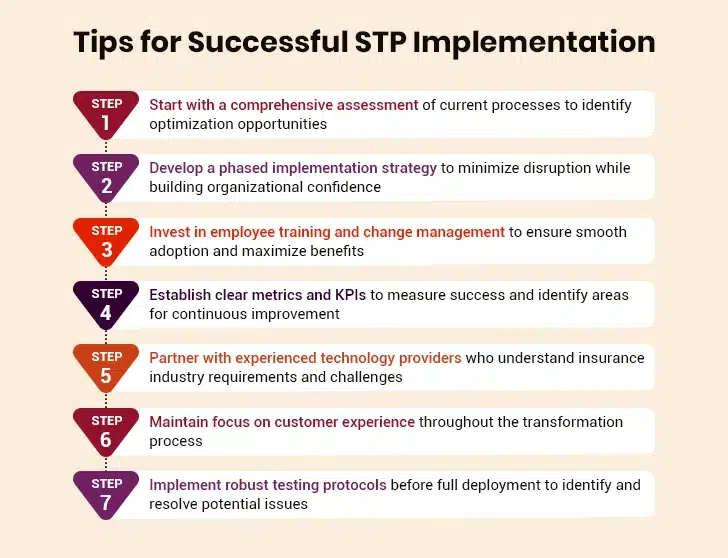The claims management process has been characterized by extensive paperwork, lengthy processing times, and manual interventions for years. This often led to delays and unsatisfied customers. Thankfully, things are changing rapidly. With new technology, the claims process is getting a major upgrade. Straight-through automation is leading the way, making everything faster and more precise.
For instance, over 300 million insurance claims are processed annually in the US alone, with traditional methods averaging 23 days for settlement. Imagine waiting this long; the experience is frustrating! Modern straight-through processing systems have revolutionized this timeline, reducing processing to a few hours for routine claims. More than operational efficiency, this transformation is reshaping customer expectations and competitive dynamics. Let’s explore how it is paving the way for insurance claims transformation.
Table of Contents
The Early Days of Claims Management
The Advent of Straight-Through Automation
Key Technologies Enabling Straight-Through Claims Processing
Benefits of Straight-Through Automation
The Early Days of Claims Management
The traditional claims management ecosystem relied on physical documentation and manual verification processes. Adjusters and clerks sifted through piles of paperwork and made endless trips to filing cabinets. Document retrieval alone could take several days, especially for older claims requiring historical reference. They verified details by hand and communicated through phone calls and letters.
This tedious process was also prone to human error, causing delays and inaccuracies. Moreover, maintaining vast archives of paper files required dedicated warehouse spaces for document storage. Weather-related ones created additional complexity, as physical site visits were mandatory for damage assessment, regardless of claim value or severity.
The advent of computers and basic software provided some relief. Data entry and storage became easier, and emails sped up communication. But the core process was still mostly manual. This was the first step toward claims processing automation, but it was just the beginning.
The Rise of Digital Solutions
With the Internet boom, the insurance industry started exploring digital solutions more aggressively. Early systems focused on digitizing existing processes rather than reimagining them entirely. Forms were filled online and documents were scanned and stored digitally. Communication channels expanded to include instant messaging and emails. These changes were significant; however, they enhanced existing manual processes rather than creating end-to-end workflow automation.
During this time, automation in insurance underwriting also gained traction. Insurers saw the potential of technology to streamline not just claims but the entire underwriting process. This set the stage for the advanced claims management systems we see today, creating an integrated approach to insurance operations.
The introduction of basic workflow management systems helped organize tasks and track progress, but human intervention remained necessary at every critical decision point. This hybrid approach provided valuable insights into the manual processes that could be entirely automated.
Despite significant technological investments, the fundamental challenge remained unchanged: manual decision-making bottlenecks continued to limit processing speed and consistency. This compelled future-focused insurers to explore more revolutionary approaches that would eventually evolve into today’s straight-through processing capabilities.
The Advent of Straight-Through Automation
Straight-through automation represents a huge leap in insurance claims transformation. Unlike earlier solutions that merely digitized manual processes, straight-through processing eliminates manual intervention altogether for routine claims. Here’s how it works:
When a claim is submitted, the system automatically verifies the details against multiple data sources. It cross-references the information with policy data. It assesses the validity of the claim and initiates the payout process — all without human involvement.
Traditional vs. Straight-Through Processing
| Aspect | Traditional Claims Processing | Automated Claims Processing |
|---|---|---|
| Processing Time | 15-30 days on an average | Approx. 24 hours for routine claims |
| Human Intervention | Required at every step | Only for complex, flagged cases |
| Error Rate | Significant due to manual entry | < 2% with automated validation |
| Fraud Detection | Manual review, reactive approach | AI-powered, proactive |
| Scalability | Limited by workforce | Unlimited digital capacity |
| Consistency | Variable by adjuster | Standardized decision-making |
As is evident, straight-through automation in claims processing is making the process easier and convenient for both insurers and insureds. That said, let’s explore the technologies that enable straight-through claims processing.
Ready to Transform Claims Processing?
Key Technologies Enabling Straight-Through Claims Processing
Modern straight-through processing systems use advanced decision trees that evaluate thousands of variables simultaneously. These systems integrate with external databases, including medical records, repair networks, weather services, and fraud detection agencies. Now let’s take a closer look at the key technologies:
- Artificial IntelligenceAI algorithms detect patterns and anomalies that would otherwise be invisible to the human eye. These systems continually learn from new data, improving their accuracy over time and adapting to emerging fraud patterns. Moreover, advanced neural networks now process unstructured data from accident reports, medical records, and repair estimates, extracting relevant information with greater accuracy. Predictive AI models anticipate claim outcomes and recommend optimal settlement strategies based on historical precedents and current market conditions.
- Machine LearningML models can predict outcomes based on historical data, enabling proactive decision-making and informed risk assessment. They analyze thousands of variables simultaneously to determine claim validity and appropriate settlement amounts. Deep learning algorithms continuously refine their understanding of claim patterns, identifying subtle correlations that human adjusters might miss. These models adapt to changing market conditions, seasonal patterns, and emerging fraud techniques without requiring manual reprogramming.
- Robotic Process AutomationRPA bots handle repetitive tasks with speed and precision, eliminating human error in routine processes. They can work 24/7 without breaks, significantly reducing processing times. Intelligent RPA systems now integrate with OCR technology to extract data from handwritten forms, images, and complex documents. These bots communicate with multiple systems simultaneously, updating records, scheduling appointments, and triggering workflows across different platforms.
- Natural Language ProcessingNLP technology enables systems to understand and interpret unstructured data from claim descriptions, medical reports, and other text-based sources, automatically extracting relevant information. Advanced NLP models process customer communications in multiple languages, detecting emotional sentiment and urgency levels to prioritize claims appropriately.
- Computer VisionAdvanced image recognition capabilities enable systems to analyze photos of damage, medical scans, and other visual evidence, allowing for preliminary assessments without human review. Modern computer vision systems can assess vehicle damage from smartphone photos with greater accuracy compared to physical inspections, dramatically reducing claim processing time and eliminating the need for in-person assessments for minor incidents.
Together, these technologies enable true claims transformation and open doors for touchless claims processing across various insurance lines. This also represents the most significant advancement in insurance operations since the introduction of computers, fundamentally altering how insurers interact with customers and manage risk.
“The insurance industry is at a pivotal moment where straight-through processing isn’t just an advantage—it’s becoming essential for survival. Companies that embrace this technology now will lead the market, while those that delay risk being left behind by more agile competitors.”
– Sarah Martinez, Senior Director of Digital Transformation, Global Insurance Innovations
Benefits of Straight-Through Automation
Straight-through automation is a boon for insurers, irrespective of their line of business. By eliminating human intervention in claims processing, it reduces the likelihood of human errors and increases accuracy. Not only this, but the benefits of using automation for insurance claims transformation are numerous, some of which are listed below:
1. Significant Cost-Savings
One of the most immediate advantages of claims management automation is cost savings. According to the latest research, insurers implementing straight-through processing solutions experience 40-70% operational cost reduction. Another research states that administrative costs decline by 35% when claims are processed using straight through automation. Automating the claims process reduces the need for large teams of adjusters and clerks. Labor costs are, therefore, significantly lower. Additionally, automating processes ensure that there are no errors. This leads to enormous savings by preventing overpayments or fraudulent claims.
2. Enhanced Efficiency
Automation dramatically reduces the period within which claims are processed. As per recent industry research, there’s a staggering 90% reduction in claims processing time, from 72 hours to under five minutes. In other words, the duration that initially took days or weeks now takes only hours, sometimes even minutes, for simple claims! This speed enhances customer satisfaction and loyalty as policyholders appreciate quick and efficient service.
Additionally, the ripple effects of improved efficiency extend beyond individual claims. Insurers can handle larger volumes without proportionally increasing staffing. Peak season claim volumes that previously required temporary staffing can now be managed effortlessly via automated systems. Emergency response capabilities improve dramatically. Resource allocation becomes more strategic as staff focus on complex cases requiring human judgment rather than routine administrative tasks.
3. Consistency and Fairness in Decision-Making
Another significant benefit is the consistency and fairness that automation brings to the claims process. Automated decision-making eliminates geographical disparities in claim settlements, ensuring customers receive consistent treatment regardless of location. Algorithmic processing removes unconscious bias related to demographics, claim amounts, or customer history. Standardized procedures reduce legal challenges and regulatory compliance issues, as decisions follow predetermined, auditable criteria.
In short, automated systems apply the same rules and criteria to every claim. This eliminates biases and ensures that all customers are treated equally. In fact, adjusters supported by AI recommendation engines resolve complex claims 35% faster while maintaining 25% greater consistency in similar claim scenarios. This standardization helps build trust and improves the overall perception of the insurance company.
4. Scalable Customer Support
Traditional claims customer support and service are tightly coupled with the number of agents and stakeholders on the team. A small team would take more time attending to customer issues, which dilute the experience, while having too many team members can attract higher costs in terms of salaries. In contrast, claims processing automation makes the task highly scalable without excessive associated costs.
In fact, digitization raises the customer satisfaction score by 10-15 points, which is necessary for businesses to thrive in the competitive insurance market. Most claims management software solutions have a modular and tiered pricing structure that adapts to business requirements.
5. Advanced Fraud Detection and Prevention
Advanced AI algorithms excel in identifying 53% more potential fraud than traditional manual review processes. By analyzing multiple data points simultaneously, these systems flag suspicious patterns for human review while processing legitimate claims seamlessly. Social network analysis identifies organized fraud rings by connecting seemingly unrelated claims. Image analysis technology detects doctored photos and staged accident scenes with greater accuracy. This saves an average of USD 4.2 millionUSD 4.2 million annually.
6. Regulatory Compliance and Risk Management
Automated systems ensure consistent compliance with regulatory requirements by building compliance checks directly into processing workflows. This reduces the risk of regulatory violations and associated penalties.
Audit trails become comprehensive and automatically generated, simplifying regulatory examinations. Compliance reporting shifts from manual compilation to automated generation. Privacy regulations like GDPR are embedded into system architecture, ensuring data protection by design. Risk management improves through real-time monitoring of regulatory changes and automatic system updates.
The benefits of straight-through claims processing are significant. At the same time, there are some challenges and considerations of utilizing claims automation that insurance companies must take care. Doing so is necessary to make the most of this revolution.
Challenges and Considerations
Despite its many benefits, adopting straight-through automation is not without challenges. Implementation and integration issues, data security concerns, and user adoption are some of the hurdles that prevent insurers from utilizing straight-through processing. Some of the common challenges include:
- Implementation and IntegrationOne primary concern is the complexity of implementation. Integrating automated claims software with existing systems and processes requires significant investment in time and resources. Insurance companies need to carefully plan and execute the transition to avoid disruptions.
- Data SecurityData security and privacy are also critical considerations. Automating the claims process involves handling sensitive customer information. This data must be protected against breaches and unauthorized access. Insurers must implement robust security measures and comply with regulatory requirements to safeguard data.
- User AdoptionIt is understandable to worry about the impact on employment because automation is taking over tasks that traditionally humans used to do. Nevertheless, rather than considering automation as a threat, it can be viewed as an opportunity for reskilling and redeployment of employees into more strategic roles which require human judgment and expertise.
The Future of Straight Through Claims Processing
The future of claims processing automation looks promising. As technology evolves, the capabilities of automation systems will change too. We can also expect more AI and ML integrations leading to sophisticated and accurate assessments in claims processing. In addition, real-time data analysis will improve fraud detection, thus promoting the integrity of the whole claim process.
On the other hand, automation in insurance underwriting will continue to advance. This will create a seamless and integrated experience from policy issuance to claims settlement. Predictive analytics will enable insurers to anticipate and prevent claims before they occur, shifting from reactive processing to proactive risk management. This represents a fundamental change in how insurance operates, moving from loss mitigation to loss prevention.
Furthermore, insurance policy automation solutions will continue to become more prevalent among insurers. They offer end-to-end automation that promotes efficiency while improving customer satisfaction.
Conclusion
The shift to straight-through automation in claims management is huge. It cuts costs, boosts efficiency, and pleases customers. Automation reduces the need for manual intervention, minimizing errors and speeding up claim resolution. Although challenges like system integration and employee retraining remain, the potential is great. Embracing this tech will pay off for insurers, leading to more reliable and efficient processes that benefit both the company and its policyholders.








